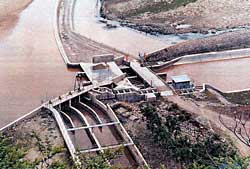 For successive governments in Kathmandu, nothing could be more of an eye-glazer than the Kyoto Protocol to cut greenhouse gas emissions. They never understood it and if they did, they didn't think it was a priority.
For successive governments in Kathmandu, nothing could be more of an eye-glazer than the Kyoto Protocol to cut greenhouse gas emissions. They never understood it and if they did, they didn't think it was a priority. Until last week. Suddenly with the big climate change Conference of Parties (COP-10) in Buenos Aires on 6-17 December looming, Environment Minister Bachaspati Debkota began the complicated task of convincing the cabinet why it was important. It wasn't easy, but he was finally able to make Prime Minister Sher Bahadur Deuba understand the benefits to Nepal.
"We convinced the cabinet it was a win-win situation and the ratification process was approved," Debkota says. Now that the cabinet has decided to go for it, the legal wheels have started rolling to get the royal ordinance that is needed in the absence of parliament. But there are still potential pitfalls. The government is in a bind since it needs to keep renewing the WTO ordinance and there is nothing in it about Kyoto. The options now are to wait till March for the WTO ordinance to be renewed again or ask the king to do us all a favour by recalling the WTO ordinance and sticking in the bit on Kyoto. This would be necessary to get Kyoto ratified by the Buenos Aires meeting next week, but the government will have to make the embarrassing admission that it goofed.
Once Nepal ratifies the protocol, it will not only join most countries in the world that want to cut greenhouse gas emissions but also reap rewards for the country's successes in renewable energy.
Under the Clean Development Mechanism (CDM) of the United Nations Framework Convention on Climate Change, countries can sell the carbon they don't burn through renewable energy and conserving forestry to polluting rich countries which need to meet their Kyoto quotas for cutting carbon dioxide emissions.
Now that the ratification process is moving, and provided there are no major hitches, Nepal can collect the $4.5 million for the carbon it has not emitted by promoting biogas. Nepal signed a letter of intent with the World Bank last July for the deal. The World Bank's Prototype Carbon Fund set up a Community Development Carbon Fund, which aims to help grassroots development schemes that offset carbon emissions.
Nepal's biogas program is regarded internationally as a model for successful use of alternative energy for the rural Third World. Each of Nepal's 125,000 functioning digesters prevents five tons of carbon dioxide from being pumped into the atmosphere every year even though some methane does leak out. Nepal has now overtaken China and India in the number of biogas plants per capita. This 'saved' gas is what rich countries are buying to reach their own emission quotas. The $4.5 million will be ploughed back into clean energy that will make Nepal eligible to trade even more carbon.
Now that ratification is on the cards, Nepal can sell more of the carbon it saves through other renewables such as hydropower and solar energy use. Several Dutch banks are said to be interested. Under the CDM, many banks broker deals in the international market between buyers and sellers. That way the countries selling saved carbon may end up getting less money than the market value.
Those countries that have not ratified the Kyoto protocol need to rely on such middlemen. "Once Nepal ratifies the protocol, it can negotiate with ultimate buyers and get the real market value," says senior accountant Ratna Sansar Shrestha who is involved in CDM deals.
Environment Ministry Under Secretary Purushottam Kunwar says Nepal will now be heard when it talks about damage to the Himalayan environment from climate change at the Buenos Aires meeting. "Now that we are in Kyoto we will be in a better position to push the issues," he says. "It also makes sense for Nepal to join Kyoto before it comes into force on 16 February 2005."
After ratification of the Kyoto Protocol, Nepal will be entitled to all such benefits without having to cut its per capita carbon emission which are still below quota limits. Even China and India don't have to reduce their current emission levels, but Kyoto requires industrialised countries to cut their greenhouse gas emissions by 5.2 percent of the 1990 baseline by 2012.
RELATED ARTICLE
EDITORIAL: Ratify Kyoto >>
COMMENT: Why Nepal needs Kyoto >>
CLIMATE CHANGE: "Mt Everest is not melting" >>


